Related Research Articles
The Bronze Star Medal (BSM) is a United States Armed Forces decoration awarded to members of the United States Armed Forces for either heroic achievement, heroic service, meritorious achievement, or meritorious service in a combat zone.
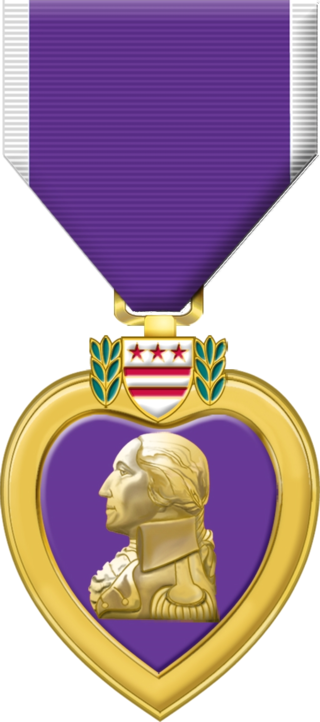
The Purple Heart (PH) is a United States military decoration awarded in the name of the President to those wounded or killed while serving, on or after 5 April 1917, with the U.S. military. With its forerunner, the Badge of Military Merit, which took the form of a heart made of purple cloth, the Purple Heart is the oldest military award still given to U.S. military members. The National Purple Heart Hall of Honor is located in New Windsor, New York.
The Combat Action Ribbon, is a high precedence United States Navy, United States Coast Guard, and United States Marine Corps military decoration awarded to United States sea service members "who have actively participated in ground or surface combat."

The United States Armed Forces awards and decorations are primarily the medals, service ribbons, and specific badges which recognize military service and personal accomplishments while a member of the U.S. Armed Forces. Such awards are a means to outwardly display the highlights of a service member's career.

The Combat Infantryman Badge (CIB) is a United States Army military decoration. The badge is awarded to infantrymen and Special Forces soldiers in the rank of colonel and below, who fought in active ground combat while assigned as members of either an Infantry or Special Forces unit of brigade size or smaller at any time after 6 December 1941. For those soldiers who are not members of an infantry, or Special Forces unit, the Combat Action Badge (CAB) is awarded instead. For soldiers with an MOS in the medical field they would, with the exception of a Special Forces Medical Sergeant (18D), receive the Combat Medical Badge. 18D Special Forces Medics would receive the Combat Infantryman badge instead.
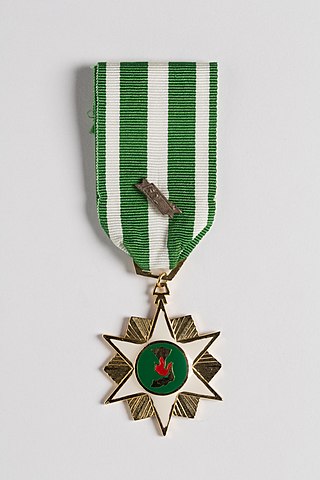
The Republic of Vietnam Campaign Medal, also known as the Vietnam Campaign Medal, is a South Vietnamese military campaign medal which was created in 1949, and awarded to French military personnel during the First Indochina War. During the Vietnam War, the South Vietnamese government awarded the Republic of Vietnam Campaign Medal with Device to members of the South Vietnamese military for wartime service and on March 24, 1966, to members of the U.S. military for support of operations in Vietnam. In May 1966, other allied foreign military personnel became eligible for the award.
The Vietnam Service Medal is a military award of the United States Armed Forces established on 8 July 1965 by order of President Lyndon B. Johnson. The medal is awarded to recognize service during the Vietnam War by all members of the U.S. Armed Forces provided they meet the award requirements.
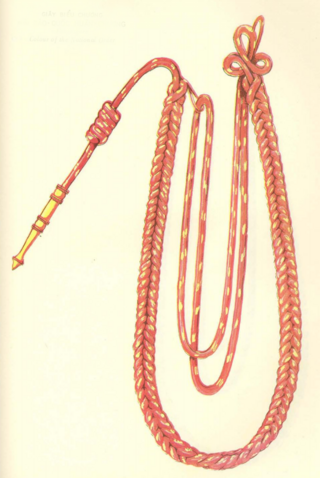
The National Order of Vietnam was a combined military-civilian decoration of South Vietnam and was considered the highest honor that could be bestowed upon an individual by the Republic of Vietnam government.

The Cross of Valour is a Polish military decoration. It was first introduced by the Council of National Defense on 11 August 1920. It is awarded to an individual who "has demonstrated deeds of valour and courage on the field of battle." It may be awarded to the same person up to four times. The medal is given only in wartime or shortly after.
Between 1947 and 1991, during the years of the Cold War, a large number of military awards and decorations were created by various nations to recognize the undeclared hostilities of the era. Military medals of the Vietnam War and the Korean War are the best known due to the extreme level of the conflicts.
The following outline is provided as an overview of and topical guide to the Vietnam War:
Authorized foreign decorations of the United States military are those military decorations which have been approved for wear by members of the United States armed forces but whose awarding authority is the government of a country other than the United States.
Awards and decorations of the Vietnam War were military decorations which were bestowed by the major warring parties that participated in the Vietnam War. North Vietnam, South Vietnam, Australia, New Zealand and the United States all issued awards and decorations to their personnel during, or after, the conflict.

Captain Humbert Roque "Rocky" Versace was a United States Army officer of Puerto Rican–Italian descent who was posthumously awarded the United States' highest military decoration—the Medal of Honor—for his heroic actions while a prisoner of war (POW) during the Vietnam War. He was the first member of the U.S. Army to be awarded the Medal of Honor for actions performed in Southeast Asia while in captivity.

Maxwell Reid Thurman was a United States Army general, who served as Vice Chief of Staff of the United States Army and commander of United States Army Training and Doctrine Command.
Resolution for Victory Order is a Vietnamese military order. It was given to generals Đoàn Khuê, Võ Nguyên Giáp, Trần Văn Trà among others during the Vietnam War to show resolve for victory by any means necessary. It is similar to other medals and badges awarded by North Vietnam during the era such as the Defeat American Aggression Badge.
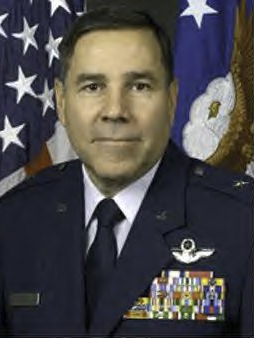
Brigadier General José M. Portela (Ret.),, is a retired officer of the United States Air Force who recently retired from the position of Assistant Adjutant General for Air, which he held while also serving as commander of the Puerto Rico Air National Guard. In 1972, Portela became the youngest C-141 Starlifter aircraft commander and captain at age 22. Portela is also the only reservist ever to serve as director of mobility forces for Bosnia. He is also the first native of Puerto Rico to hold the rank of Brigadier General in the United States Air Force Reserve.
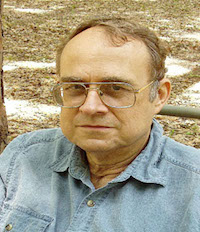
Michael Lee Lanning is a retired U.S. Army lieutenant colonel and the author of military non-fiction.
The Liberation Order Badge is a military badge given during the Vietnam War by North Vietnam.
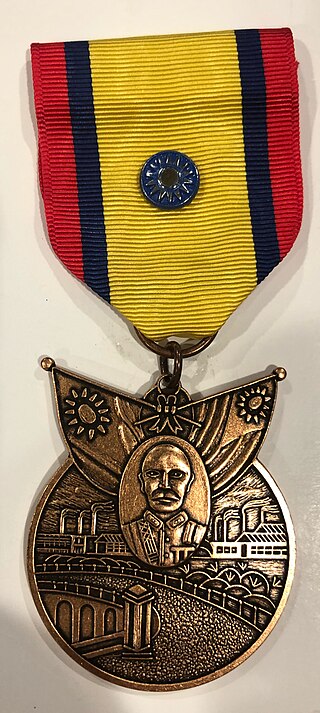
This China War Memorial Medal, also known as the Medal in Commemoration of Victory in the Resistance Against Aggression was authorized after the Second Sino-Japanese War by the Republic of China government for servicemen who assisted the Chinese Government fighting against the Japanese during the war. Members of the Fourteenth Air Force, the Flying Tigers, were eligible to be awarded this medal. The medal was created in 1944 and first distributed in 1946 to those who met the requirements from the Chinese Nationalist Government. Lt. General Claire Lee Chennault and Anna Chennault were a few who had received this medal.
References
- ↑ "Emering,Early Viet Minh and NVA Medals, Defeat American Aggression Badge". www.emering.com.
- ↑ "The Defeat American Aggression Badge - North Vietnam Medals Post-WW2". 11 April 2019.